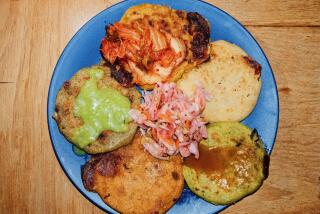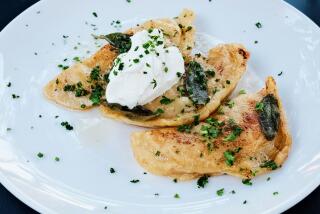A Fortress Town Alive With History
- Share via
SEGOVIA, Spain — It is all but impossible not to compare the elevated old section of this magnificent Castilian town to a ship, the wedge-shaped alcazar cutting bow-like through stately poplars and splitting twin river beds 300 feet below.
Segovia’s role in Spanish history and unification is a major one, thanks to the bit of palace intrigue here that proclaimed Isabella the Catholic ruler of Castile in 1474. And because Isabella was already married to Ferdinand, heir apparent to the crown of Aragon, the power stage was set to unite Spain.
Ferdinand and Isabella also began the Inquisition in Segovia, which was to wrack the country until the 19th Century.
The town also has a formidable lode of Romanesque churches, most of them of warm ochre stone, as is the cathedral.
Yet walk from the arcades of Plaza Mayor down Calles Juan Bravo and Cervantes to the aqueduct and let the aura of a Castilian fortress town of El Cid’s day engulf you.
Here to there: Iberia flies nonstop LAX-Madrid-LAX every Sunday during summer, TWA regularly via New York. Or take a domestic carrier to New York or Miami for connections with Iberia or Aeromexico. A train or bus will get you Madrid-Segovia in about two hours.
How long/how much? One or two days should take in most of the sights, including a half-hour drive out to Pedraza for a look at one of Spain’s most perfectly preserved pueblos. Spanish prices for food and lodging are a boon to any traveler’s wallet.
A few fast facts: The peseta was recently valued at about 143 to our dollar. Weather is tolerable anytime from late spring to late fall, winters rather raw, summers not quite as scorching as in many places on Spain’s central meseta.
Getting settled in: Hotel Los Linajes (Dr. Velasco 9; $42 double, high season, $33 low) is built from an 11th-Century palace owned by one of the town’s noble families, although present furnishings are contemporary. It’s in the old walled section of town, several small patios and gardens, a fine old place that serves all meals in summer, breakfast and snacks only off season.
Residencia Las Sirenas (Juan Bravo 30; $30 high season, $25 low) is a three-star Hostal Residencia, which means that it serves no meals. Yet the location is midway down the main shopping street with good cafes and restaurants nearby. Also a flower-lined balcony at rear overlooking the lower town.
Acueducto (Avenida P. Claret 10; $35 high season, $28 low) is another contemporary hotel just given a renovation. Location convenient, rooms very comfortable, restaurant and cafe.
Regional food and drink: Roast suckling pig, cochinillo asado, is the regional dish of Castile, with cordero lechal, milk-fed baby lamb, running it a close second. Judiones del real sitio seems to be Segovia’s unique dish, a marvelous preparation of large white beans in a tomato-and-herbs sauce. Hare, quail and partridge grace many menus, the last wondrous as perdiz en escabeche, marinated in herbs, oil and vinegar and served either hot or cold as an entremese.
Spain’s wines can be roughly divided into those from the major areas of Rioja and Valdepenas, the first more noble in character, the latter very good table wines and often most commendable. With the exception of seafood, red wines seem to go better with sturdy Spanish dishes.
Moderate-cost dining: Meson de Jose Maria (Cronista Lecea 11) gets our solemn nod as the town’s best. Owner Jose Maria Ruiz Benito couldn’t be more affable, really knows wines and has his walls covered with bottle bins from his vineyards in the Duero River Valley, the equal of many Riojas we’ve drunk. He also served us by far the best tapas of the trip, marble-size cuttings of pig tails braised in and coated with a sauce to please the gods. Ask Jose Maria for his cola de lechon.
Casa Duque (Calle Cervantes 12) opened the doors in 1895 and it’s the meson tipico to end them all. Serrano hams hanging from the ceiling, rustic wood beams, beautiful ceramic tiles, a place to savor Castilian decor. All the typical dishes here, but try truchas gran duque, fresh trout broiled with Serrano ham in the Pamplona fashion, then anointed with a piquant dressing laced with garlic, oil and laurel.
Meson de Candido (Plaza Azoquejo 5), just beneath the aqueduct, is known all over Spain for its formidable table and the three generations of Candidos who have raised it to lofty heights. So picturesque that your mind reels, dine here on such as venison cutlets with orange, crayfish bisque, caldereta de cordero de pastora, a hearty shepherd’s lamb stew with red peppers and garlic. And of course there is always cordero and cochinillo asado Segoviana, lamb and piglet from a clay oven.
Going first-class: Parador Nacional de Segovia (Carretera de Valladolid; $46 low season, $60 high) was abuilding on our last visit, now one of the most impressive in the nationwide chain of 80 or so. A bold and massive use of contemporary architecture, many rooms with balconies overlooking the town from its hillside perch.
Outdoor pool in summer, a heated one within for when it’s nippy, sauna and just about any amenity you can name. The dining room upholds the reputation of paradores for fine regional dishes prepared with care, brisk service and an excellent selection of Spain’s best wines. Our veal cutlets with wild mushrooms were superb, the garlic soup Castellana their equal.
On your own: After the aqueduct and cathedral, start a round of the Romanesque churches, making sure to visit San Esteban with its handsome tower and spire, and 12th-Century San Martin near the lovely plaza of the same name. This is the historic center of old Segovia, yet near the main shopping area.
The 14th-Century alcazar has been destroyed and rebuilt a number of times. Still, it is one of Spain’s most heroic structures, the cliff-top setting unlike any other we know. Within there is an armory and other trappings of medieval days, views from the turrets and battlements spectacular.
We urge you to take the few hours for a visit to Pedraza, if only for a short time in Plaza Mayor. Its wood and earthen arcades and porticos convey an unforgettable feeling for what life must have been like in Spain during Inquisition times. Indeed, the Hosteria Pintor Zuloaga, once a court during those trying centuries, is about the only place to dine in the village. Hours are iffy, but if open, the food is worth the trip.
For more information: Call the Spanish National Tourist Office at (213) 658-7188, or write (8383 Wilshire Blvd., Suite 960, Los Angeles 90211) for a colorful 16-page booklet on Segovia with map and location of sights, a list of hotels and another map of all Spain. Ask for the Segovia Package.
More to Read
Sign up for The Wild
We’ll help you find the best places to hike, bike and run, as well as the perfect silent spots for meditation and yoga.
You may occasionally receive promotional content from the Los Angeles Times.






